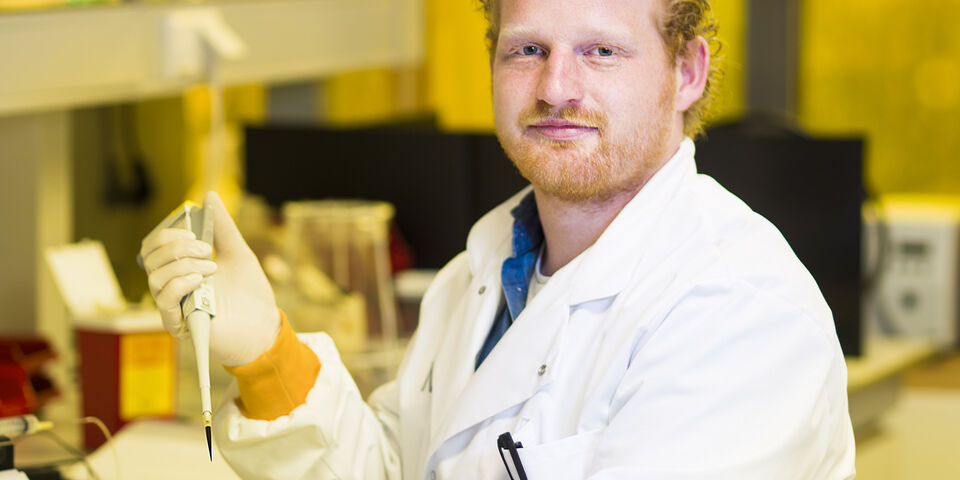Home Stretch | Gold for an early diagnosis
Biomedical Engineering student Michiel Twisk is conducting his graduation research in two groups of different departments. At Chemical Biology (Biomedical Engineering) he made a molecule that you can use to coat gold particles, and at Molecular Biosensing for Medical Diagnostics (Applied Physics and Biomedical Engineering) he is using this molecule to test a new principle for a biosensor.
While this is an inspiring challenge, he does not always find it easy to graduate in two research groups, Michiel Twisk explains in Flux. “Here at Applied Physics they did wonder during the first few months how long the synthetization of a new molecule could actually take. Normally they just buy their molecules over here. And for me as a Biomedical Engineering student it was difficult to judge what exactly it was they expected from me.” With a few more months ahead, Twisk’s graduation adventure appears to be a success after all. “Indeed, my work may even form the basis for a publication.”
The laboriously cleared first hurdle involved the attachment of a so-called thiol group to a molecule which is called nitrilotriacetic acid (NTA). Thanks to the thiol group the NTA molecule adheres to the gold nanoparticles. This enables the molecule to act as a sort of hook which much larger protein molecules can hang on to in turn. As the gold particles absorb certain colors of light very strongly, and that color is influenced directly by the number of bonding protein molecules, you can observe the protein molecules that would otherwise be invisible to us indirectly via the ‘color-changing gold particles.
“In the end you want to create a cheap system this way that allows you to detect biomarkers; proteins that indicate the presence of a certain disease”, says Twisk. “If you can indicate those biomarkers in very low concentrations as well, you can make a diagnosis at a very early stage in the disease process – possibly even before patients develop serious complaints. This would be a way to some extent to curb the healthcare costs that are getting out of control.”
An important aspect of this new type of biosensor that Twisk is working on, is that the proteins do not bond too strongly to the molecular ‘hook’. “In fact they should let go again after a number of seconds, and then bond again.” It is precisely this process that brings about a jump in the measurement signal, so that far smaller concentrations of proteins can be detected than if the proteins were to stick for a very long time. The benefit of this method is actually that the same molecule is measured several times, as it were, which results in a more reliable signal. Moreover, in principle this method makes it possible not only to determine the presence, but also the concentration of the biomarkers. Twisk: “There is a direct link between the frequency at which these proteins bond and the concentration in the sample.”
At Molecular Biosensors for Medical Diagnostics they have probably already succeeded in making individual proteins visible by means of gold particles, the graduating student explains. “However, as they have used molecules for this with a much stronger bond, which means they stay in place for too long, they have been unable to prove this statistically at extremely low concentrations. It is likely that my system can do this.”


Discussion